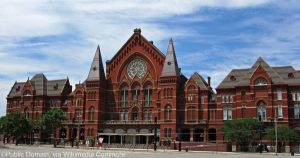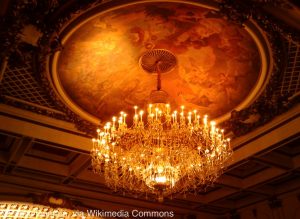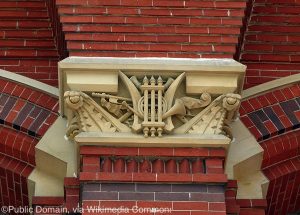Do Spirits Haunt Cincinnati Music Hall ?
 If music can, indeed, calm the hearts of wild animals, might it not also calm the restless spirits of those who have died and wander the earth as ghosts? John Kachuba, author of Ghosthunting Ohio cannot think of any better place to find the answer to that question than at Cincinnati Music Hall.
If music can, indeed, calm the hearts of wild animals, might it not also calm the restless spirits of those who have died and wander the earth as ghosts? John Kachuba, author of Ghosthunting Ohio cannot think of any better place to find the answer to that question than at Cincinnati Music Hall.
Built in 1878, the redbrick Victorian Gothic structure rises majestically on the corner of 14th and Elm streets. Central Parkway runs parallel to the rear of the building now, but when Music Hall first opened its doors, that thoroughfare was actually the Miami Canal. Designed by a local architectural firm, the edifice is eccentric, with its garrets, turrets, gables, insets, nooks, broken surfaces and planes, and ornate rose window. Some witty Cincinnatians have dubbed the style “Sauerbraten Byzantine.”
The building is located upon the site where the tin-roofed wooden Sangerhalle once stood, a hall built by a German immigrant singing society, the Saengerbund, for its May Festivals. But there is also a more somber atmosphere associated with other former occupants of the site. The present Music Hall rests upon the foundations of the 1844 Orphan Asylum. Before that, it was the Commercial Hospital and Lunatic Asylum with its Pest House, a section for the indigent with contagious diseases. A potter’s field also occupied the site, the final resting place for suicides and strangers, the indigent and homeless of Cincinnati, as well as those who died in the Pest House. These unfortunates were buried without the benefit of coffins; they were simply bundled up and dropped into the earth. Over the years, there have been many renovations to Music Hall and human bones have often been unearthed during construction.
 The famous Cincinnati journalist Lafcadio Hearn wrote about one such discovery in the October 22, 1876, edition of the Cincinnati Commercial:
The famous Cincinnati journalist Lafcadio Hearn wrote about one such discovery in the October 22, 1876, edition of the Cincinnati Commercial:
“This rich yellow soil, fat with the human flesh and bone and brain it has devoured, is being disemboweled by a hundred spades and forced to exhibit its ghastly secrets to the sun…you will behold small Golgothas—mingled with piles of skulls, loose vertebrae, fibulas, tibias and the great curving bones of the thigh…All are yellow, like the cannibal clay which denuded them of their fleshly masks…Bone after bone…is turned over with a scientific application of kicks…dirty fingers are poked into empty eyesockets…ribs crack in pitiful remonstrance to reckless feet; and tobacco juice is carelessly squirted among the decaying skulls…by night there come medical students to steal the poor skulls.”
Hearn reported that the dead began to make themselves known to the living just shortly after these macabre discoveries were made. Shadowy figures roamed the halls at night, and ghostly dancers were seen in the ballroom on the second floor. One exhibitor at a business fair in Music Hall saw a young, pale woman in old-fashioned clothing standing by his booth. As he approached her, he felt a sudden rush of cold air as the figure became transparent then disappeared. Hearn wrote: “The tall woman had been sepulchered under the yellow clay below the planking upon which he stood; and the worms had formed the wedding-rings of Death about her fingers half a century before.”
Half a dozen skeletons were unearthed by workers in 1927, placed in a cement crypt and reburied, only to be discovered again during a renovation in 1969. The bones were placed inside another concrete box and reburied—and uncovered in 1988 for the third time when the shaft for the concert hall’s freight elevator was deepened. It seems the dead at Music Hall simply cannot rest in peace. Pieces, yes, but peace? No.
When my wife, Mary, and I lived in the Cincinnati area, we attended several performances of various kinds at Music Hall, but that was before we had ever heard the ghost stories, and we had never been behind the scenes. We were lucky enough, however, on a recent Valentine’s Day, to have a tour of Music Hall led by Marie Gallagher, a volunteer there for 25 years. It was a public tour, and we were joined by approximately two dozen people who were interested in seeing the grand old building. We gathered in the Main Foyer, with its checkerboard marble floor and graceful columns.
 Marie knew every nook and cranny of Music Hall and regaled us with tales and anecdotes about some of the famous people who had performed there—John Philip Sousa, Richard Strauss, Igor Stravinsky, Leonard Bernstein, Jascha Heifitz, Maria Callas, Andres Segovia, Luciano Pavarotti, Count Basie, Miles Davis, Bob Dylan; the list is endless.
Marie knew every nook and cranny of Music Hall and regaled us with tales and anecdotes about some of the famous people who had performed there—John Philip Sousa, Richard Strauss, Igor Stravinsky, Leonard Bernstein, Jascha Heifitz, Maria Callas, Andres Segovia, Luciano Pavarotti, Count Basie, Miles Davis, Bob Dylan; the list is endless.
The heart and soul of Music Hall is the 3,630-seat Springer Auditorium. Marie led us up into the gallery where we could look down at the burgundy colored seats and the stage. Even though larger than most concert halls, the acoustics in Springer Auditorium are said to be the best in the country, if not the world. Ed Vignale, Jr., Music Hall’s facilities engineer, told me in a later conversation that a person standing in the gallery of the empty auditorium could hear someone speaking from behind the stage as though he or she were only 20 feet away from the listener. Could it be that such perfect acoustics are the explanation for some of the ghostly sounds heard at Music Hall?
“I hear them when I’m on duty alone at night,” says Kitty Love, who has been part of the private police force at Music Hall for 21 years. “Footsteps, doors slamming, and music playing, and I know I was the only one in the building.”
Kitty has heard the footsteps and slamming doors in the stage area of Springer Auditorium and in other parts of the building’s south side, the side that was built over the cemetery.
As our tour group stood in the gallery of the auditorium, gazing out at the magnificent 1,500-pound crystal chandelier suspended from the dome ceiling and its Arthur Thompson oil painting, “Allegory of the Arts,” I thought of what Kitty had said and took a few pictures with my digital camera. (Later, when I download the images to my computer, I will find three beautiful but unexplainable orbs floating in the otherwise clear air above the gallery.)
Marie continued to lead us on the tour—the enormous backstage area with its vertiginous catwalks barely distinguishable in the darkness high above us, the massive workshop where stage sets and props are built, the costume room with its many rows of outfits of every description hung around and above us like an enormous dry cleaner, the dressing rooms that resembled high school locker rooms, and the more luxuriously appointed dressing rooms of the stars.
When the tour concluded back in the Main Foyer, Marie took us aside privately and brought us back into an office area. In this section was a freight elevator, the very elevator beneath which a small casket of bones from the old cemetery was uncovered.
“I haven’t seen or heard anything unusual in Music Hall and I don’t believe in ghosts,” said Marie, “but this is where a security guard said he heard strange music. He was so impressed by what he heard, he wrote it all down.”
She handed me a file folder containing a photocopy of security guard John G. Engst’s handwritten account of what he experienced on February 22, 1987. In it he tells how he was escorting three caterers from a party held in Music Hall’s Corbett Tower down to the first floor in the elevator. It was about 12:30 a.m. As they descended, the three women asked him if he heard music. He said he did not, but they asked him again when they reached the first floor and this time he said he had heard it. The women told John they had heard the same music when they went up to Corbett Tower a few hours earlier but didn’t think much of it then.
After the women loaded their truck and drove away, John went back to the elevator. The music, sounding something like a music box, continued to play a tune that John thought he recognized as “Let Me Call You Sweetheart.” John stopped the elevator at different levels to see if the music would still be audible. It was. He wrote, “It was as beautiful as ever, but I’m getting more bewildered.”

John checked all the areas outside the elevator at the various levels but could not find any source for the music. He was so frightened and awed by his experiences that he wrote, “For nearly two weeks I could not approach the elevator shaft on the first floor late at night without my whole body tingling.”
In the final analysis, however, the experience was an affirming, life-altering one for John Engst. He wrote: “The experience is now all positive and will be forever, I now believe. I pray more intensely, don’t fear death and am glad to have had this profound experience.”
Kitty Love has heard similar ghostly music at Music Hall but in different locations from the freight elevator. “You hear music playing somewhere late at night when you know no one is there, but when you get there, you find it coming from some other place. You go to that place and then you hear it coming from yet another place.”
Ed Vignale said a musical greeting card had been found at the bottom of the elevator shaft, but that didn’t convince Engst that there was a rational explanation for the music he heard. Maybe John is right. Those greeting cards don’t usually last very long nor do they play continuously. Once opened they play only a few seconds before they must be closed and reopened to play again. Could a card have been heard continuously for several hours? And what about the ethereal music Kitty heard in other parts of Music Hall? Are there ghosts roaming Music Hall?
Even though Ed Vignale said that he has never seen nor heard spirits in the 34 years he has worked at Music Hall, he admits that some people have told him of seeing men and women dressed in late-19th-century clothing walking through the halls of the building. Other people have said that sometimes an extra unknown “cast member” may appear in an operatic production or that unusual looking figures may appear among the audience.
“There is definitely something strange going on here,” Ed said. “In all the time I’ve worked here, I’ve only seen two mice and one rat in the building, very unusual for a building of this size and age.” Ed went on to say that during a 1967 production at Music Hall called wild Animal Cargo, two baby snakes, a python and boa constrictor, somehow disappeared and were never found. The show left town without them and Music Hall was left with a unique system of rodent extermination.
How long do those snakes live anyway? One can only hope that, if they are still alive, those creatures have long ago been tamed by the musical charms of Cincinnati Music Hall’s resident spirits.
Copyrights: Public Domain, via Wikimedia Commons